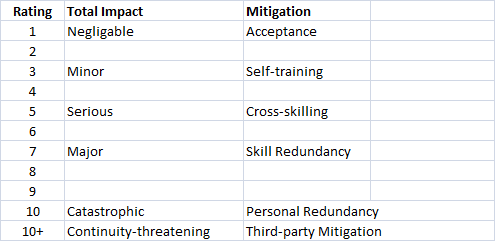Having a skill gap or loss is inevitable throughout the lifetime in a company. The only person who knows how to maintain a system might be ill or on holiday the day that system goes down. A process might not work without someone who’s unofficially stepping in to cover a gap, and now they’ve left the company. Someone has been promoted, but no one’s there to fill the shoes they left behind. Retirement sometimes seems to come as a surprise, and years of experience goes with them unless you’ve passed on what they have learnt.
When it is for a short while, perhaps these things are manageable. You might be able to string on a day or two without needing to interfere. But it is a sign of bigger things that need attention, a sign that somewhere you might be facing a larger challenge if someone in your team decides they would like to pursue opportunities in another company. While there are many factors involved in determining how much effort you should put into covering skill gaps, on the whole this is most visible when someone leaves the company permanently, whether for their career or through retirement, hence my focus on turnover as a factor. The other major factor in determining your response should be the effects of losing that skill on your core business. Your business will be fine when a supporting task or administrative task lags behind, but when your business’ operation slows down or stops it is much more serious.
Redundancy Management
So, we can say that a Skill Interruption can be for a short while (conjunctural) or a long time (structural). We know the impact of this skill gap can be anywhere from Minor to Critical. And we might be able to decide whether covering that skill gap requires knowledge, skill or experience. Finally, acquiring the requirements to cover that gap might be easy or hard, quick or slow, and the cost implications of leaving matters unattended can also be low or high.
This gives us a rough table showing us what kind of skill gaps we may expect, and with that we can prepare ourselves for addressing skill gaps by deciding what level of redundancy we might need:

What you see here are the various factors involving skill gaps, in a table. You now have to consider the situation of your own department or company, and decide how much impact each of these factors has. If you have access to free internal trainings, for example, knowledge becomes much less of a pressuring factor. Experience combined with time pressure is almost always a powder keg, however. The difficulty acts as a base level, while everything else modifies that number.
See here an example of a table I filled in with what I would consider standard levels of impact for each category:

As you can see, a low-difficulty task one could learn with a free online training, for which there is plenty time to prepare, would have a rating of 1 at most. A high-difficulty critical skill permanently lost requiring experience primarily while under time pressure would be rated at 10 or 12. And that number might even be a low estimate.
Redundancy and Mitigations
It is best to use this table well ahead of time, and look at big process flows, not singular tasks. If you find specific gaps, give them a rating and then you can decide what manner of actions you might take to remedy the problem. For example, you might decide on one of the following actions:

Acceptance: Just tide over while the person involved comes back, usually these kinds of tasks can be delayed or even safely ignored for some time. Performance reviews, monitoring and a lot of process improvement tasks fall in this category.
Self-training: This is where you ask or motivate your team to learn the basic operations of each other’s tasks through online training or process descriptions. Alternately, the task is quick to learn through online training when the need arises. A good example here is when people in a process chain that runs between departments have knowledge of each other’s work so they can help quickly get replacements up to speed who need to connect into this chain.
Cross-skilling: Here it is important that you have permanent potential replacement in place. Some tasks anyone in the team must be able to handle, other tasks might have two designated process owners. This combines best with well described processes and an automated system that can reroute requests or notifications to alternate process owners.
Skill Redundancy: Beyond performing tasks, this means two people are capable of covering the exact same role. An example would be having two people trained in Project Management in presales, or two people who have the required system access to audit the financial information.
Personal Redundancy: At this point we need the people themselves being fully redundant. They are high-skilled, highly experience individuals and often have security clearances or mandate that cannot easily be replicated. A good example would be someone who has the final say on any Purchasing, anyone at the C-level, or someone who is the only one with the skill to maintain or repair a critical process or system that would threaten the company’s existence if it were to fail. Here you need to make sure a second person has or acquires the necessary skills and rights to perform the job ad-interim, but also be coached by, and shadowing, the primary process owner. You want the discrepancy in the two people’s skills to be as minimal as possible.
Third-party Mitigation: When you reach these levels of threat, you may need to consider having a third party capable of resolving any skill emergencies you might have. For example, if a system goes down and needs repair, but not only is it business critical, there are only a handful of people in the country who know how to fix it, you may need to already have prepared a list of people you can contact in case of an emergency. The cost will be high, because these people have valuable and irreplaceable skills, but if the future of your company is at stake, this might be your only option.
Of course, preparing for these things ahead of time is much more preferable than dealing with emergencies at the last moment. Someone who is retiring should not be a surprise, and you should have had enough time to prepare for that. You may not be able to control whether a critical asset decides to leave the company, but you know that this might happen. People with highly demanded skills can and do move between companies, so be prepared for this.
By having each role in the company, and each task, observed for their impact and required mitigation, you can remain operational even when people performing a critical role fall away long-term. Not only does this provide necessary contingency for your company’s continuity, it also reduces stress and uncertainty among your team members, and prevents the loss of additional people due to stress and overtaxing their ability to cope with gaps.
It is important not to overdo this and fall into the trap of spreadsheet-management. This is a quick tool to decide for yourself how big the cost would be of a process or task failing, and what you might do to mitigate this. It should really be limited to core business processes. But doing this and occasionally updating this assessment will be a great tool in making sure that your company, department or core business are not brought down by someone not being available to keep it going.
And of course, the biggest caveat in any leadership position: don’t forget yourself!
